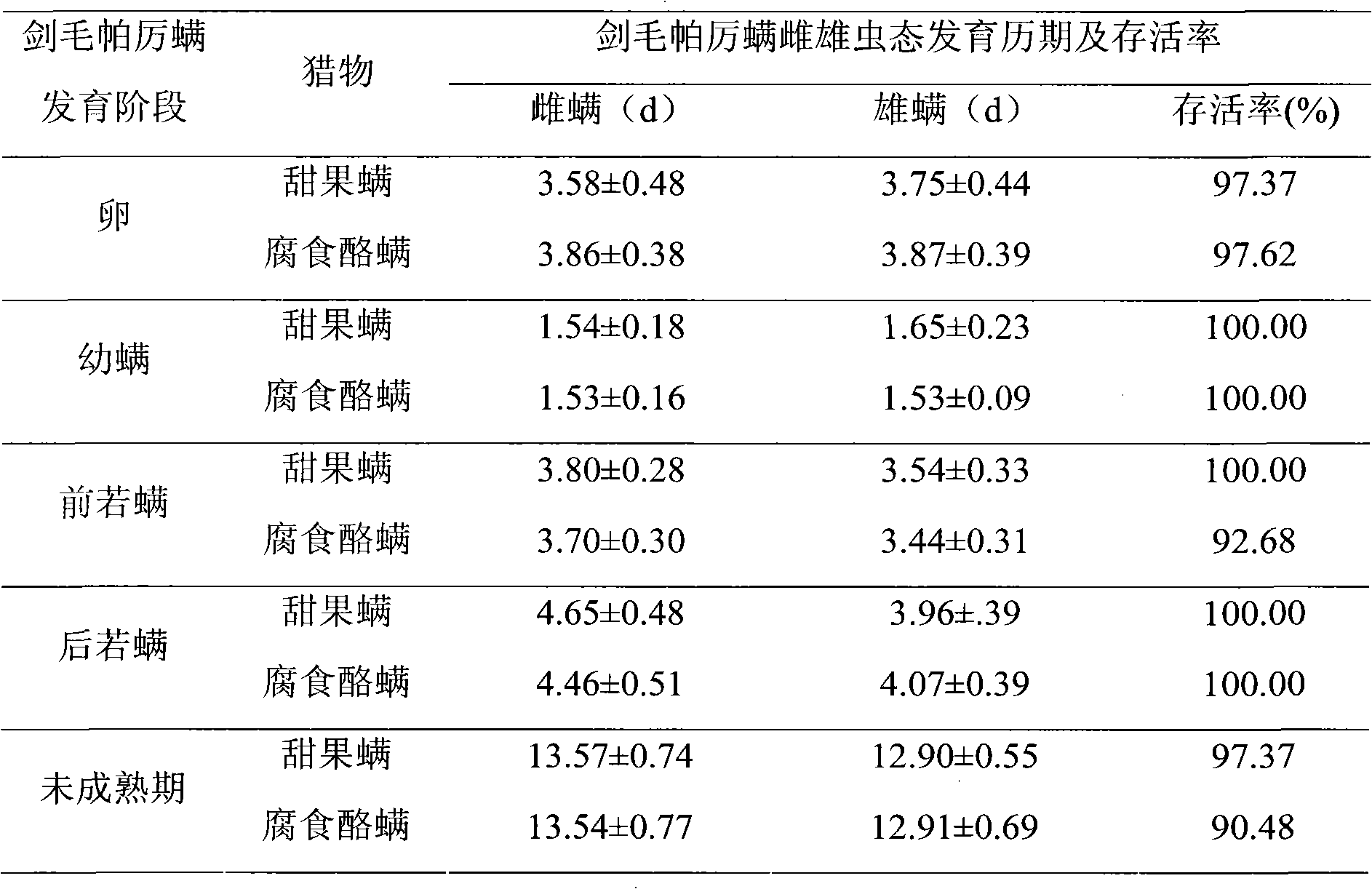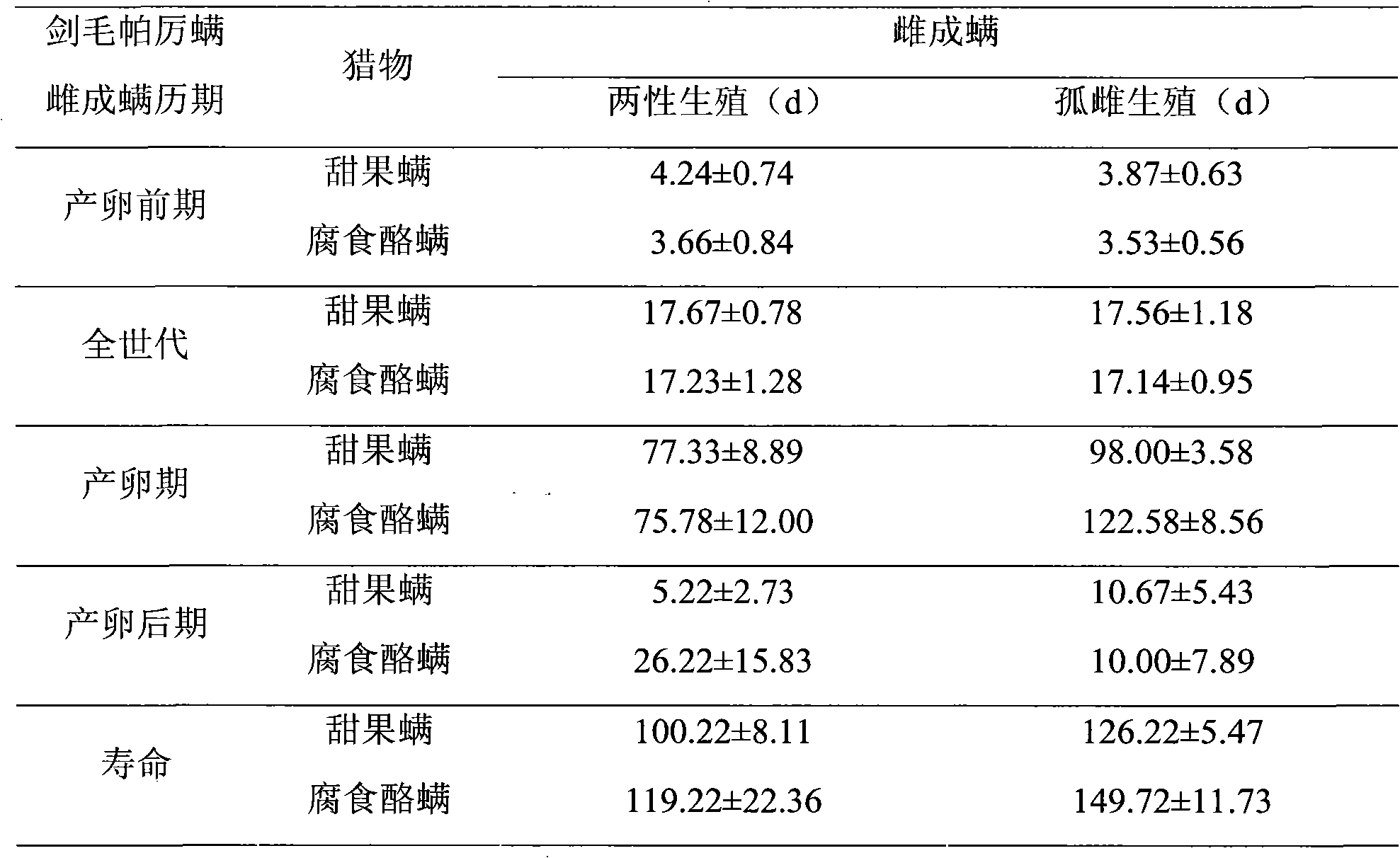Method for breeding large amount of Stratiolaelaps scimitus and Hypoaspis aculeifer (Canestrini) artificially
A technology for the sword-haired laxa mites and the lower shield mites, which is applied in the directions of animal feed, animal feed, food processing, etc., can solve problems such as unfavorable proliferation of the sword-haired laxa mites, and achieves good water retention effect, efficient propagation and lightening. Effects of Environmental Pollution
- Summary
- Abstract
- Description
- Claims
- Application Information
AI Technical Summary
Problems solved by technology
Method used
Image
Examples
Embodiment 1
[0020] Example 1 See Table 1 for the amount of predation of Parlelea lanceolata in a 24°C, 100% RH fresh-keeping box to adult tyrophagous mite
[0021] It can be seen from Table 1 that female, male, and nymphs of P. sapiens can prey on adults of Tyrophagous sarcoptera; the predation amount of female adults is the largest, followed by nymphs, and male adults are the least.
[0022] Table 1 The predation amount of Paleopsis swordhair mite on adults of Tyrophagous mite
[0023]
Embodiment 225
[0024] Example 225 ° C, 100% RH conditions under the conditions of sweet fruit mite and tyrophagous tyrophagous on the growth and reproduction of Paleopsis sword hair.
[0025] 1) See Table 2 for the effects of two prey species on the immature stage of each mite stage of P. It can be seen from Table 2 that, feeding on sweet fruit mite and tyrophagous tyrophagous mite, Paleopsis swordhair mite can complete the growth and development of the immature stage.
[0026] 2) See Table 3 for the effects of sweet fruit mite and tyrophagous mite on the maturity and lifespan of female adults of P. It can be seen from Table 3 that the adult female mite of the two prey mite mite P.
[0027] 3) See Table 4 for the number of eggs laid by sweet fruit mite and tyrophagous mite under the two reproductive modes of female adult mite of P. It can be seen from Table 4 that under the two prey conditions, the female adult mite of the sword hair handkerchief can lay more than 50 eggs in a lifetime.
...
Embodiment 3
[0034] Example 3 Effects of sweet fruit mite on the growth, development and reproduction of Paleopsis sword-hair mite under different temperature and 100% RH conditions.
[0035] 1) See Table 5 for the developmental stages of each adult female mite. The immature stage of female adult mite was the longest at 16°C, and the female adult mite did not lay eggs at 32°C.
[0036] 2) See Table 6 for the developmental stages of each mite stage of male adult mites. The male adult mite of the sword-haired handkerchief was the longest at 16°C, followed by 32°C.
[0037] 3) See Table 7 for the survival rate of Paleopsis swordhair mite from egg development to adult mite stage. The survival rate of the immature stage of the sword-hair mite can reach more than 90% at 20°C-28°C, the highest at 24°C, and the lowest at 32°C. The immature stage survives with the increase of temperature at 16°C-24°C. The survival rate increased gradually; at 24°C-32°C, the survival rate decreased with the increa...
PUM
 Login to View More
Login to View More Abstract
Description
Claims
Application Information
 Login to View More
Login to View More - R&D
- Intellectual Property
- Life Sciences
- Materials
- Tech Scout
- Unparalleled Data Quality
- Higher Quality Content
- 60% Fewer Hallucinations
Browse by: Latest US Patents, China's latest patents, Technical Efficacy Thesaurus, Application Domain, Technology Topic, Popular Technical Reports.
© 2025 PatSnap. All rights reserved.Legal|Privacy policy|Modern Slavery Act Transparency Statement|Sitemap|About US| Contact US: help@patsnap.com



